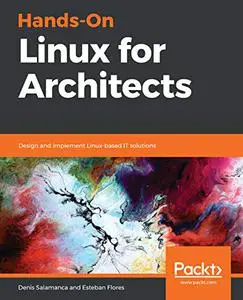Denis Salamanca, Esteban Flores, "Hands-On Linux for Architects: Design and implement Linux-based IT solutions"
English | 2019 | ISBN: 1789534100 | EPUB | pages: 380 | 20.0 mb
English | 2019 | ISBN: 1789534100 | EPUB | pages: 380 | 20.0 mb
Explore practical use cases to learn everything from Linux components, and functionalities, through to hardware and software support
Key Features
- Gain a clear understanding of how to design a Linux environment
- Learn more about the architecture of the modern Linux operating system(OS)
- Understand infrastructure needs and design a high-performing computing environment
Book Description
It is very important to understand the flexibility of an infrastructure when designing an efficient environment. In this book, you will cover everything from Linux components and functionalities through to hardware and software support, which will help you to implement and tune effective Linux-based solutions.
This book gets started with an overview of Linux design methodology. Next, you will focus on the core concepts of designing a solution. As you progress, you will gain insights into the kinds of decisions you need to make when deploying a high-performance solution using Gluster File System (GlusterFS). In the next set of chapters, the book will guide you through the technique of using Kubernetes as an orchestrator for deploying and managing containerized applications. In addition to this, you will learn how to apply and configure Kubernetes for your NGINX application. You'll then learn how to implement an ELK stack, which is composed of Elasticsearch, Logstash, and Kibana. In the concluding chapters, you will focus on installing and configuring a Saltstack solution to manage different Linux distributions, and explore a variety of design best practices. By the end of this book, you will be well-versed with designing a high-performing computing environment for complex applications to run on.
By the end of the book, you will have delved inside the most detailed technical conditions of designing a solution, and you will have also dissected every aspect in detail in order to implement and tune open source Linux-based solutions
What you will learn
- Study the basics of infrastructure design and the steps involved
- Expand your current design portfolio with Linux-based solutions
- Discover open source software-based solutions to optimize your architecture
- Understand the role of high availability and fault tolerance in a resilient design
- Identify the role of containers and how they improve your continuous integration and continuous deployment pipelines
- Gain insights into optimizing and making resilient and highly available designs by applying industry best practices
Who this book is for
This intermediate-level book is for Linux system administrators, Linux support engineers, DevOps engineers, Linux consultants or any open source technology professional looking to learn or expand their knowledge in architecting, designing and implementing solutions based on Linux and open source software. Prior experience in Linux is required.
Table of Contents
- Introduction to design methodology
- Defining GlusterFS Storage
- Architecting a storage cluster
- Using GlusterFS on cloud infrastructure
- Analyzing Performance in a Gluster system
- Creating a Highly available self-healing Architecture
- Understanding the core components of a Kubernetes cluster
- Architecting Kubernetes on Azure
- Deploying and Configuring Kubernetes
- Monitoring with ELK stack
- Designing an ELK Stack
- Using Elasticsearch, Logstash, and Kibana to Manage Logs
- Solving Management Problems with Salty Solutions
- Designing a salt solution and Installing the software
- Design Best Practices
- Assessments



